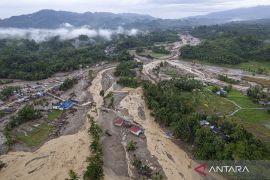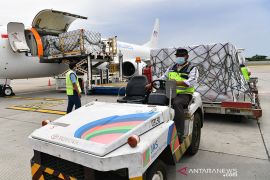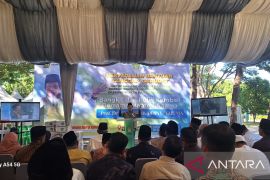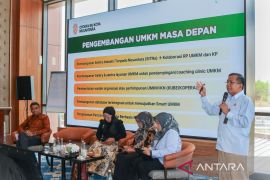In most OECD countries affected by COVID-19, the internet quality is still relatively stable. Although regions throughout Italy, Spain, and somewhat surprisingly, Sweden, are showing signs of strainJakarta (ANTARA) - Researchers at the Monash Business School have created a Global Internet Pressure map that measures the strain the COVID-19 pandemic is putting on internet infrastructure in countries across the world.
According to them, the internet infrastructure has become strained in Malaysia, Italy, Iran, Spain and Sweden.
With COVID-19 and associated self-isolation measures transforming working practices internationally, the demands on the internet infrastructure have begun to bite,
new data from a commercial spin-off from the Monash University has revealed.
Dr. Klaus Ackerman, Associate Professor Simon Angus, and Associate Professor Paul Raschky, economists at Monash University and co-founders of KASPR DataHaus, a Melbourne-based alternative data company have researched how enormous volumes of data on global internet activity can be used to infer human social and economic behavior.
Related news: Indonesia needs Rp278 trillion infrastructure investment to boost Internet connectivity
Under KASPR DataHaus, they have developed a technology that collects and processes, on a daily basis, billions of measurements on internet activity and quality for any location in the world.
The team has produced a Global Internet Pressure map that is publicly available and is being updated regularly via the KASPR Datahaus website. Users can explore the global observations using a dashboard and download the data for specific countries.
Using data from 13-14 February, 2020 (Thursday to Friday) as a baseline, the researchers were able to observe changes in internet latency patterns that emerged on 12-13 March, 2020 (Thursday and Friday), as many countries announced major lockdowns on travel, work, and business.
Associate Professor Paul Raschky explains: “We call this difference in measure, between the first days of the lock-down period, and the baseline period in early February, ‘Internet Pressure’, since if it is greater than zero, it exposes latency, or speed issues, starting to affect millions of internet users across these regions."
“While the values may seem relatively small, such as 3 per cent or 7 per cent, such a difference is far from normal, and indicates that many users are probably experiencing bandwidth congestion. More people at home means more people online – with big bandwidth appetites,” he said.
“The situation is not dissimilar to a family trying to make their way through a crowded subway tunnel. Your streaming video or video upload during teleconferencing is made up of thousands of small packets of information; these packets need to find their way down copper and fibre-optic cables across vast distances. The more streaming packets trying to make the journey at once, the more congested the pathway, and the slower the arrival time,” he continued.
By focusing on regions within countries having at least 100 confirmed COVID-19 cases as of Friday (13 March), the researchers were able to examine how each nation’s internet was performing, given the rapid spike in home-based entertainment, video-conferencing, and communication taking place online.
The findings of Monash University researchers at least provide an interesting view of what is now a global reality. When a government is faced with the option of quarantining an area, the pressure on internet infrastructure cannot be avoided.
“In most OECD countries affected by COVID-19, the internet quality is still relatively stable. Although regions throughout Italy, Spain, and somewhat surprisingly, Sweden, are showing signs of strain,” Dr. Raschky noted.
At the time of the study, researchers said, Malaysia appeared as something of an anomaly. Despite having a relatively small number of confirmed cases on 13 March, the day they accessed the latest figures, the country’s internet pressure readings were far more outsized, sitting above China, Italy, South Korea, Spain and Japan – all countries with confirmed caseloads that were several times larger.
What about Indonesia? The surge in the number of positive cases of COVID-19, which are continuing to grow every day, shows the spread of coronavirus infections has far from slowed in Indonesia.
The Indonesian government is currently considering the option of "scaling social restrictions with civil emergency or taking social restrictions with legal discipline”, said Indonesian President Spokesman Fajrul Rachman on Monday (30/3).
Two weeks ago, there was a dramatic surge in the number of online users playing games such as Mobile Legends and Fortnite after the government appealed to students to to study at home, not to mention when government agencies and offices began to issue work-at-home guidance for employees. In addition, based on the monitoring of several Indonesian cellular operators, there was a surge in data traffic of 7-15 percent.
This certainly provides an additional task for Indonesian cellular operators to continue to provide the best service in wake of the spike in internet usage as students and workers stay at home, according to the General Chair of the Indonesian Information Technology Federation (FTII), Andi Budimansyah.
Meanwhile, the Indonesian Government has decided to extend its work-from-home guidance till April 21, 2020 to curb transmission of the coronavirus disease.
The work-from-home policy has been promulgated in response to the state of emergency declared by the National Disaster Mitigation Agency (BNPB) over the COVID-19 outbreak, said Minister of Administrative and Bureaucratic Reforms, Tjahjo Kumolo.
The government has left the implementation of the work-from-home policy to regional heads, so they can take into account the situation in their region and developments reported by the COVID-19 task force to tailor the policy to their needs, he said.
"Not all of them (regional work-from-home policies) will automatically be the same, if we look at the spread of COVID-19 in each region," he said.
Secretary of the Administrative and Bureaucratic Reforms Ministry, Dwi Wahyu Atmaji, said the extension of the work-from-home period was announced via a ministerial circular (number 34 of 2020).
The first work-from-home period ended on Tuesday (March 31, 2020).
The decision to extend the work-from-home guidance will be evaluated periodically based on developments related to the spread of COVID-19, he added.
Related news: Government builds high-speed Internet infrastructure
Related news: Megaport Launches Megaport.ORG to Support and Advance Internet Communities, Standards and Infrastructure
Editor: Mulyo Sunyoto
Copyright © ANTARA 2020











